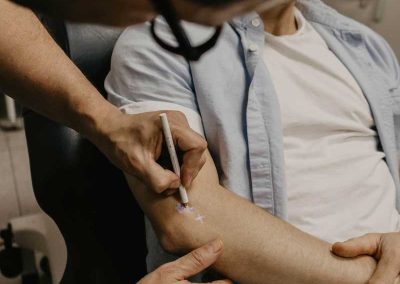Platelet Rich Plasma (PRP)
PRP or Platelet Rich Plasma, has become a popular technique in aesthetic medicine and is considered to be the only natural method to regenerate your skin without the need of added active ingredients.
PRP treatments involve the process whereby we introduce your growth-factor-containing-platelets into the skin to stimulate a powerful regenerative process which in turn stimulates an abundance of healthy collagen production.
Although blood is mainly a liquid (called plasma), it also contains small solid components (red cells, white cells, and platelets). The platelets are best known for their importance in clotting blood. However, platelets also contain hundreds of proteins, called growth factors, which play an important role in the healing of injuries.
PRP is plasma with many more platelets than what is typically found in blood. The concentration of platelets and, thereby, the concentration of growth factors can be 5 to 10 times greater (or richer) than usual.
Frequently Asked Questions
Is this treatment safe?
Since the platelets come from the patient’s own blood, there is absolutely no possibility of allergic reaction or other side effects. The only precaution you need to take is to stop any anti-inflammatory or blood thinning medications while administering PRP.
PRP procedures can be mildly uncomfortable however the patient is well numbed before starting the treatment, so most find it quite comfortable. The greatest risk is mild bruising, redness, sensitivity, swelling and mild peeling while the patient heals.
What happens during the procedure?
To develop a PRP preparation, a sample of your blood is drawn – similar to how you would take blood for tests at the doctor. The blood is drawn into specialised vials and spun down using a machine; platelets are separated from other blood cells and their concentration is increased during a process called centrifugation. The PRP is then harvested and ready to be used in the desired area.
How are the treatments performed?
Local anaesthetic is applied to the area before the procedure is performed to minimise discomfort.
There are three ways in which this procedure can be done:
The first is that the full amount of PRP extracted can be injected by your doctor in the superficial layers of the skin using the Mesotherapy technique.
The second is that the full amount of PRP can be introduced into the skin via a microneedling device (Dermapen), and this can be performed by your doctor or a therapist.
A third option is a combination option. Your doctor can take the most concentrated part of the PRP and inject this into the area of most concern and the remainder of the PRP can then be microneedled into the skin.
What procedures are commonly performed with PRP?
- Wrinkle Improvement: fine wrinkles, eye wrinkles, wrinkles around mouth and forehead wrinkles.
- Skin Colour: improved circulation can treat dark circles under the eyes, areas of poor colour and dull complexion.
- Skin Texture: reduction of skin pore size, improvement in skin elasticity and skin tone.
- Hair Restoration: because the platelets contain vital growth factors, PRP injections are naturally a good fit for stimulating lost hair follicles.
- Sexual Rejuvenation: a revolutionary use for PRP includes the treatment of erectile dysfunction with a procedure known as the P-shot, as well as feminine intimate wellness rejuvenation with techniques such as the O-shot and V-shot.
- Other Applications: treatment of stretch marks, scars, burn wounds, joint therapy, sports injuries, rejuvenation of hands, décolleté and neck.



